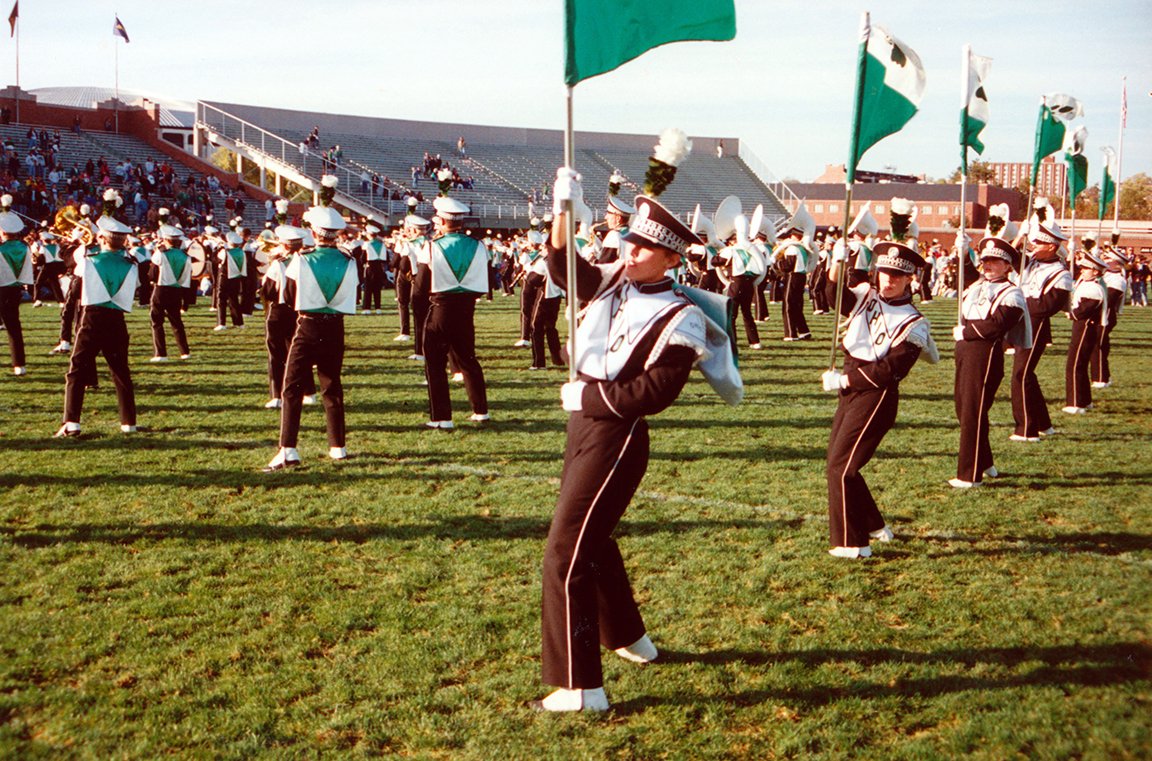Confessions of a reluctant writer and devoted 110 alumna
In hindsight, it maybe wasn’t the best idea I’ve ever had to try to write about Ohio University’s Marching 110. My personal experience with the topic—I was in the band’s flag section from 1990 to ’93—makes it an easy topic to report on; but, being so close to the material makes objectivity challenging.
You see, the software that runs the Marching 110 lives at my core. I’ve been known to say, “Everything I learned about leadership, I learned in the Marching 110.” The importance of accountability. The necessity for collaboration. Homecoming every year is like Christmas: a tremendous gift of camaraderie, shared passion, and performance that I get to relive with some of the best people I will ever know.
Like most worthwhile things in life, the Marching 110 is also a series of remembered pains: physical and emotional. Some of the hardest work I’ve ever done. Long hours. Sleepless nights. The worst sunburn ever. Torn quads, blown knees, and twisted ankles. Anxiety over marching a perfect show. Wrong turns. Missed cues. Inviting Amy DeBennedetto Eterovich, BSHS ’92 (who marched next to me for two years), to kick me because I’d screwed up … and wanted to kick myself.
Writing a story that captures that experience, and interviewing a couple of people I’ve known for longer than I’d care to admit, turned out to be harder than I’d imagined. More than once when talking with accomplished band directors, I had to say, “Pretend I don’t know anything about this band.” I had to forget that I’d stood in those huddles with Matt Brunner, BMUS ’95, MM ’05, in fall ’93 and that he, the field commander, was good at inspiring us, as the Man (legendary Marching 110 director Ronald P. Socciarelli) said, to be “better than the best ever”—so damned good, in fact, that he’s now in his ninth year as director of athletic bands at Temple University. I can’t remember what he would say to motivate us, but I remember believing that we could be flawless, that we could be great, as we lined up and waited for the drum cadence to signal us to drive on.
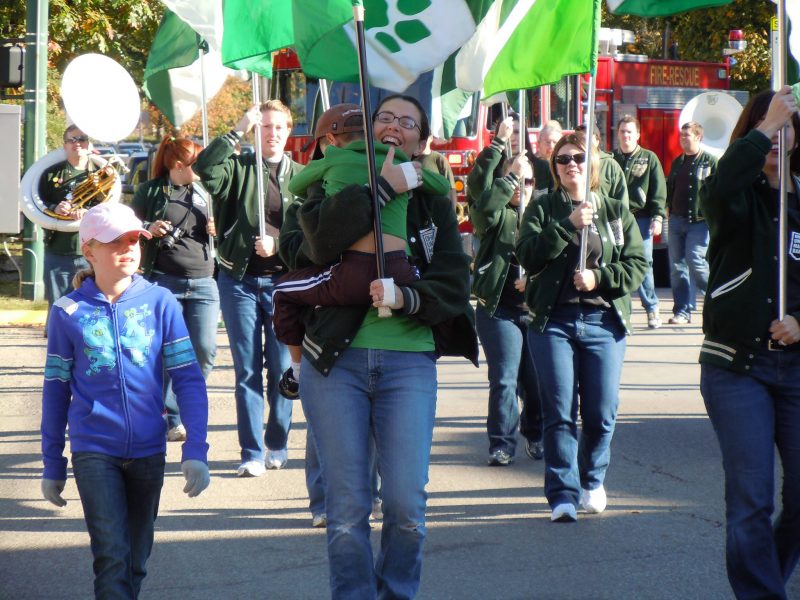
The 2010 Homecoming Parade proves a family affair for Bowie (center). Her then 5-year-old son, John, runs out from among parade viewers to greet his mother. Bowie marches in the Marching 110 Alumni Band with her daughter, Hannah, then 9. Photo by Douglas Bowie, BSC ’94, MCTP ’07, husband/father of the lot.
Memories of greatness leave a lasting impression.
Now that this narrative is written, nostalgia seeps in. The memories of four Marching 110 seasons and, ahem, 21 Alumni Band Homecomings, form an adrenaline-filled fog, a blur of familiar faces, and a cacophony of “Ain’t Been Good” and “Stand up and Cheer!”
I am part of OHIO’s marching band alumni community. And it is part of me. Sharing that experience through this narrative—itself a huddle—has been an honor. And, like everything else I associate with my 110 experience, it was really, really hard work. —Jennifer Shutt Bowie, BSJ ’94, MS ’99, is executive director, Advancement Communication & Marketing. She was a member of the Marching 110’s flag section from 1990 to ’93 and has marched in every Homecoming parade since 1990 except for one (in 2004, when pregnant with her oldest son, John).
The Marching 110 represents Ohio University across the state, country, and world.
The 2015-16 season alone took students from Peden Stadium to Cleveland’s FirstEnergy Stadium to a bowl game in Alabama, and to Paris, France. Marching 110 alumni also represent at the baton—for more than 140 bands around the globe. "Ohio Today" talked with a few collegiate band directors who shared stories and insights about what OHIO taught them about teamwork: connection, leadership, excellence, and community.
A special 110 connection: Honey, it was good in December 2015
Dec. 22, 2015, the Toledo Rockets met the Temple Owls at the Marmot Boca Raton Bowl. The Rockets won the football contest, but Ohio University ruled halftime. Both marching bands took the field under the direction of Bobcats—Matt Brunner, BMUS ’95, MM ’05, for Temple, and Andrew “Tiger” Rhodes, MM ’07, for Toledo—who learned their craft in OHIO’s Marching 110.
“I’d heard about the 110 as a freshman in high school,” said Brunner, a native of Dover, Ohio. “Then, my junior year, I got to see them. I thought, ‘I have to go there!’ because the band was so good, so entertaining.”
Rhodes was seven when he moved to Athens from Indiana, and his dad went to work for the design firm Hilferty. Rhodes could hear the Marching 110 practicing from his house. His family witnessed them at football games and the annual varsity show. “The first marching band I’d been around at all was the 110,” he said. “Having that experience, watching that band, I had some tools to use when I started working with bands.”
Performing at a bowl game proved exciting by itself for the bands. The two Bobcats provided their squads with an additional once-in-a-lifetime memory beforehand. Brunner had written an arrangement of Andy Grammer’s “Honey, I’m Good” that both units performed earlier that season. “We did a battle of the bands by the alumni tents before pregame,” explained Rhodes. “We took turns, then played that one tune together. It knocked all of the people out.”
Brunner added, “It was really fun to pull that off. Whenever you have these two bands going back and forth, then you can bring two bands together, it shows camaraderie. Suddenly, you have 400 people playing together. The people who were watching got a real kick out of them.”
The connection continued after the music stopped. Students from the two bands mingled and talked shop. “The teams are out there trying to kill each other, and the band kids are asking, ‘How can we get together?’” said Rhodes. “It was the hardest thing in the world to get them to stop socializing and go into the stadium.”

Students set marching orders
In 1923, Ohio University student Homer Baird, GEN ’26, organized the first meeting for counterparts interested in forming a marching band. More than 40 musicians gathered in Ewing Hall and a marching band was born.
Today, the Marching 110 stands on the same student commitment and leadership that inspired Baird.
“Every good and great college band has a strong leadership core from its students,” said Ken Will, BMUS ’08, MM ’13, director of the University of Dayton marching band. “The students have to pick that up and carry that torch. That has really defined what the 110 has become.”
The Marching 110 compels students to take charge.
“I inherited a tremendous work ethic and commitment to excellence with this band,” said Richard Suk, director of the Marching 110. “One of the only ways we have to recognize excellence is to put students on staff.”
Students lead each squad of four who performs marching maneuvers. Students also lead the band’s nine sections: clarinets, alto saxophones, tenor saxophones, mellophones, trumpets, trombones, euphoniums, sousaphones, and percussion. Each has music and marching section leaders. Students who excel at organization manage logistics including uniforms, instruments, and sheet music. “It’s a model that has worked well for this band. We took the ball, and we ran with it,” said Suk.
“One of the remarkable things about the 110 is that it’s self-generated. The organization and the structure come from within,” said David Turrill, BMUS ’92, MM ’06, assistant professor of music, director of bands, and chair of the music department at Muskingum University. “I was always amazed about how much the student staff was responsible for.”
The highest student position is field commander, selected by the directors and responsible for “the fundamental marching technique,” according to the band’s website. “Other duties include the heightening of morale, discipline, and esprit d’ corps.”
Brunner, in his ninth year as director of athletic bands at Temple, is a former 110 field commander. “Those moments in the huddle, before going onto the field, are your last chance to get everyone together and to get them motivated to perform their best,” he said. “Being a part of that, you see how close everyone is. You’re all right there beside each other.”
Brunner’s Temple band includes more than 200 students, only a fraction music majors. “I can’t control everything: That is the biggest point I make with my students,” he said. “My whole philosophy of teaching is to be there to teach them so they won’t need us anymore. That was the 110 right from the get go. You were responsible.”
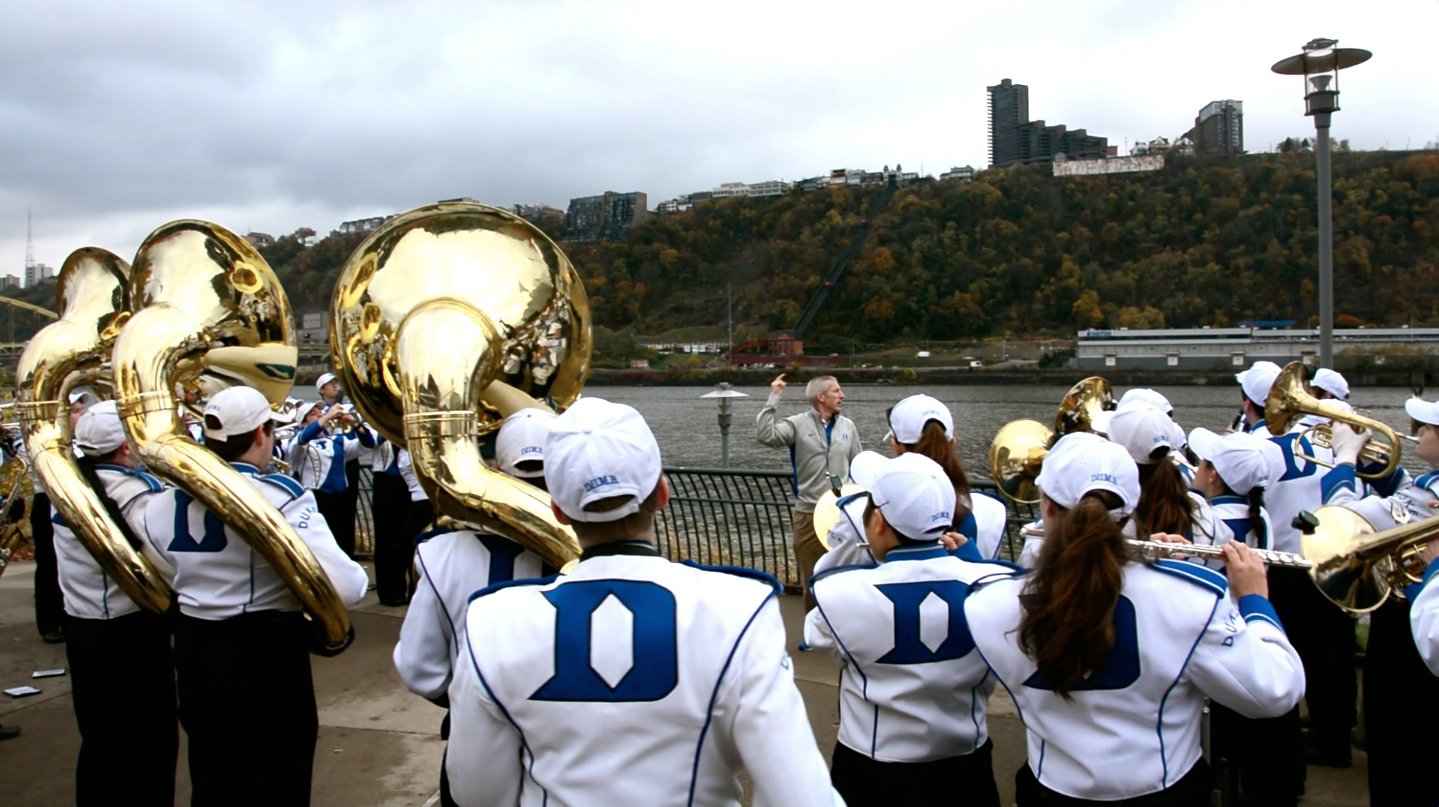
Jeff Au, BMUS ’94, prepares the Duke University Marching Band for the Duke vs. Pitt football game at Pittsburgh’s Heinz Field in 2014. Photo courtesy of Jeff Au
Jeff Au, BMUS ’94, director of Duke University’s marching and pep bands for 11 years, also depends on student leadership. His bands have no assistant directors or teaching assistants, “so student leadership is crucial,” he stated. In an e-mail interview, he shared that a student officer board is hands-on in running the band. “There is no one who just has a title without any work to do, and everyone understands that his or her role is his or her job,” he said. “If they don’t do it, it won’t get done. It is a lot of responsibility that is handled incredibly well by our students. And they don’t complain. And I love them for that.” He loves how the Marching 110 put the interrelated fundamentals of self-reliance and unity in place for him, too.
Rhodes agrees. “The level of teamwork in the 110 is fabulous. To achieve that level of student buy-in takes time. It has been developed like a well-oiled machine,” he said. “Watching that student commitment unfold at OHIO taught me that leadership is about more than getting to be the person in charge with the title, standing on the tower, or at the podium. You simply can’t do it all. You have to put trust into your students.”

Marching toward excellence
Ohio University’s Marching 110 works to be “better than the best ever.” Coined by Ronald P. Socciarelli, EMERT ’93, who directed the band from 1973 to ’89, the ideal is still heard on the practice field and in pre-game huddles. It also served as the University’s Homecoming theme in 2012 to honor Socciarelli upon his death that February.
Au marched under Socciarelli and later served as a 110 teaching assistant. He said “the intensity of purpose was incredible. Putting absolutely everything into what we were doing at any given moment. Always striving to march a perfect show. Not being satisfied with anything but my absolute best. Not only making each phrase or note the best, but making each part of each note the absolute best. … The intensity is truly unsurpassed anywhere and possibly unparalleled.”
University of Toledo upholds that ideal, too. “What one person does affects the whole product,” said Rhodes. “We make it clear to students that ‘you’re part of this group now. This group has lots of history, and you carry that history with you. It’s your task to do your best to continue that tradition.’”
Turrill instills this ideal at Muskingum. “The idea of excellence is something that I’ve brought with me, the idea that perfection is something that we strive for. We can never get there, but striving for it makes us get better and better.”
That drive comes from the director at the podium, from the field commander, and from the student standing next in line. “If you don’t pull your own weight, you’re letting everyone else down. Developing that culture in your ensemble is key to its being good. That motivation comes from within and from the top down,” said Turrill.
Will, at Dayton, learned about the commitment to excellence from Suk, for whom Will marched as an undergraduate and served as a teaching assistant. “He is so generous with what he’s willing to share with his grad students and with how he mentors us as people,” Will said. “That’s why we see so many of us going on to teach at the college level. We get the bug, we really get that experience at the podium, and we graduate knowing that we can do this.”
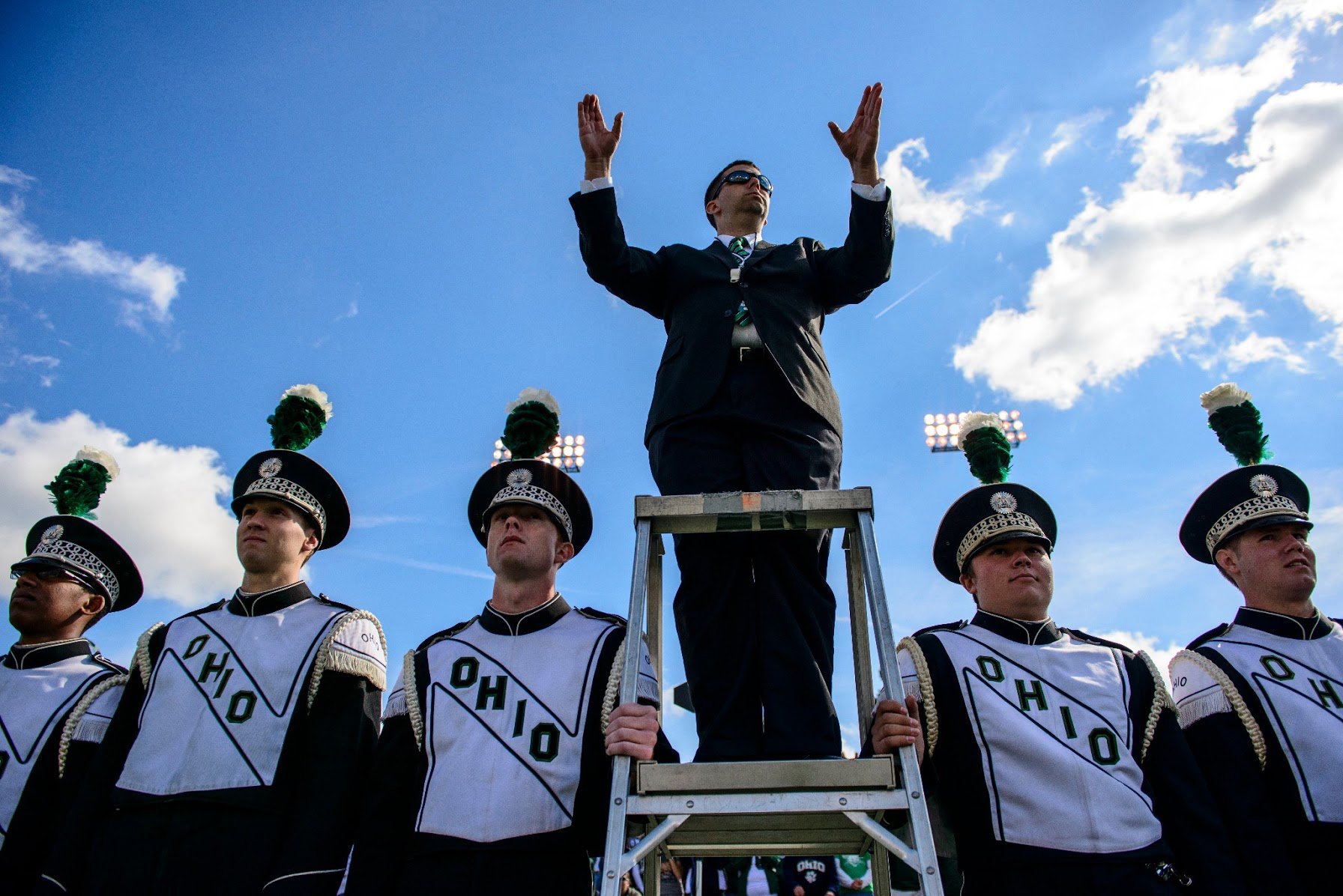
Ken Will conducts the Marching 110 as a graduate student in 2012. Photo by Brien Vincent
Striking the right note: community
Natalie Steele Royston, BMUS ’94, MM ’96, MM ’97, music education coordinator at Iowa State University, epitomizes the sense of community in Ohio University’s Marching 110 band. She began her undergraduate education at University of Oklahoma, marching in the band under “Coach” Gene Thrailkill, MED ’62—earlier the director who evolved OHIO’s band into the “110 Marching Men of OHIO” in 1967.
“It was incredible working with him,” said Royston. “I learned that the community was the most important part of the ensemble, that the people were more important than everything else. He made it a point to make sure we knew we were important individually and as a group.”

When Royston looked to transfer to a new university, Thrailkill advocated for OHIO.
“He spoke highly of his time in the band and had really fond memories. He talked about the quality of faculty and the ensembles,” she said. “He was right. I finished the last two years of my undergraduate degree and three years of grad school in Athens.”
Although not in the Marching 110 as an undergraduate, Royston served as a graduate teaching assistant in 1996-97, the first year of Suk’s tenure.
“It was a lot of fun and, honestly, a lot work,” said Royston. “I was there in the transition year. [Suk] was the new guy, and no one was sure what they thought of him yet. We helped [the students] understand that he wanted the best for them.”
That transition demonstrated the student community at the core of the Marching 110. “There are a lot of things that you get out of being in that band, a lot of areas where the band becomes part of you,” said Brunner. “But leadership was the biggest thing.”
Brunner was an undergraduate when the band transitioned from the Socciarelli’s direction to Sylvester Young, EMERT ’11. “That’s not always a positive thing for everyone, but because the student leadership was so strong, it made that changeover easy,” he said. “The ownership was already there and the discipline was there.” That discipline also smoothed the transition when Suk arrived in 1996. “This band was ready to work,” said Brunner.
Turrill was a teaching assistant with the Marching 110 in his first year of graduate school. He appreciated “the sense of community in that ensemble—the performance, the dedication, and the teamwork,” what he termed “a complete learning experience.”
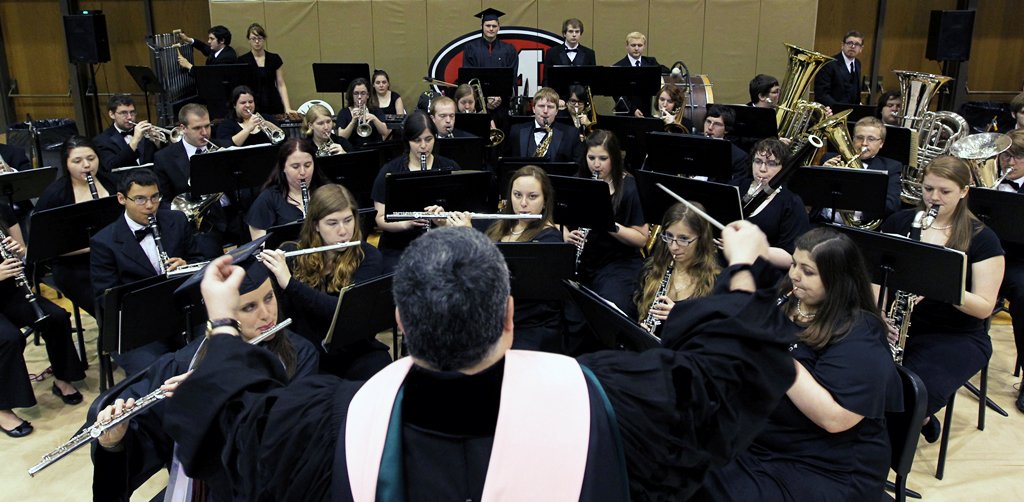
David Turrill, BMUS ’92, MM ’06, directs the Muskingum Wind Ensemble during 2013 commencement. Photo courtesy of David Turrill
When forced to pick a favorite memory, he conjured a familiar image of inclusion and celebration for OHIO graduates: “walking alongside the 110 as they march down Court Street at Homecoming,” he said. “I really have tried to bring that sense of community to Muskingum.”
Royston added to that sentiment. “We try very hard to teach future band directors that it’s about the community, to teach them that synergistic idea that the one is bigger than the parts. And how the teamwork and the cooperation mean so much more than the individual effort.”
During the end-of-season band banquet at ISU, the band watches a slide show of season highlights. “The one thing that is constant is the smiles on the faces of the students. Over the years, the faces change, but the expressions never do,” said Royston. “That joy becomes contagious, and you want to be part of that environment.” —Jennifer Shutt Bowie, BSJ ’94, MS ’99, is executive director, Advancement Communication & Marketing. She was a member of the Marching 110’s flag section from 1990 to ’93 and has marched in every Homecoming parade since 1990 except for one (in 2004, when pregnant with her oldest son, John).


